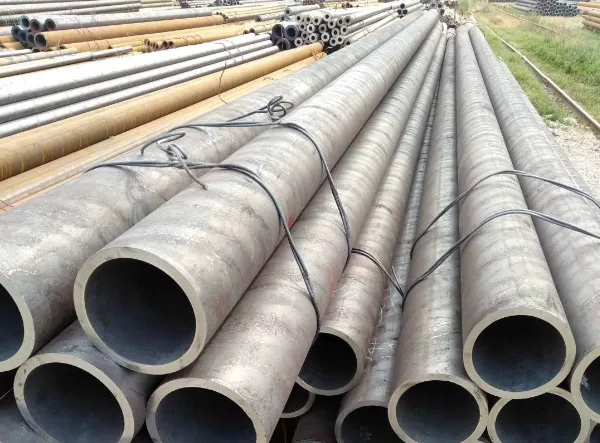A low temperature steel pipe is a specially designed carbon steel pipe or alloy steel pipe that can sustain mechanical strength and impact resistance at sub-zero temperatures. Standard carbon steel typically becomes brittle when exposed to extreme cold, leading to fractures or leaks.To prevent this, low temperature carbon steel pipes are alloyed with specific elements and undergo heat treatment processes (normalizing, quenching, and tempering) that enhance their toughness and impact strength.These pipes are primarily used in systems that handle cryogenic gases or fluids — such as liquid nitrogen, oxygen, or LNG — where temperatures can reach -150°F or even lower.
Low-temperature steel pipes come in a variety of steel types. For example, there are low-carbon steel, carbon steel, and low-temperature carbon steel. Carbon steel is further divided into low-, medium-, high-, and ultra-high-carbon steels, as well as low-alloy steel. However, each of these starts with carbon as part of its composition.
Definition and Temperature Limits of Low-Temperature Steel Pipes
Low-temperature seamless steel pipes are produced through cold drawing or hot rolling processes, with seamless cross-sections. Their core characteristic is their ability to maintain sufficient toughness even in cryogenic environments.
The industry generally categorizes them into two types based on their operating temperature range:
Low-temperature steel: Suitable for environments between -10°C and -196°C, such as ethylene plants and liquid nitrogen storage and transportation equipment.
Ultra-low-temperature steel: Suitable for extreme environments below -196°C, such as liquid hydrogen (-253°C) pipelines.
Definition of the low-temperature limit varies slightly between countries. For example, China uses -20°C, while the United States and Russia use -30°C. However, actual industrial application temperatures can drop to -253°C or even lower.
ASTM A333 / ASME SA333
The most recognized standard for low temperature steel pipes is ASTM A333 / ASME SA333, which defines seamless and welded carbon and alloy steel pipes suitable for low-temperature services.
Common grades include:
Grade 1 – General low-temperature use
Grade 3 – Enhanced toughness and weldability
Grade 6 – The most widely used grade for LNG and cryogenic systems
All A333/SA333 grades undergo Charpy V-Notch impact testing to ensure toughness at sub-zero temperatures, typically at -50°F (-46°C) or lower.
Steel grades and performance characteristics of low-temperature pipes (seamless steel pipes for low-temperature pipelines)
Cryogenic pipes are suitable for use as seamless steel pipes in low-temperature pressure vessels and heat exchangers with temperatures ranging from -45°C to -195°C.
Seamless Steel Pipes for Cryogenic Pipes:
Product Specifications: 8-1240 × 1-200mm (1/8"–48" × SCH5S–SCH160, STD, XS, XXS).
Product Materials: 16MnDG, 10MnDG, 09DG, 09Mn2VDG, 06Ni3MoDG,
ASTM A333 - Grade 1, Grade 3, Grade 4, Grade 6, Grade 7, Grade 8, Grade 9,
Grade 10, Grade 11
To ensure the practical value of cryogenic pipes, they must be supplemented with other metals. Monitoring gas cannot guarantee a completely sealed environment; after all, workers' gloves will still come into contact with GB/T18984_2003 cryogenic pipes during welding. In some special cases, such as when welding large objects, the arc may be used as a gas conditioner to optimize the welding frequency. This requires isolation, followed by a costly and complex chemical treatment process. PAW, a method not currently used in overhead crane manufacturing, is primarily used in the military industry.
Advantages of Low Temperature Steel Pipes
Superior Toughness: Maintains impact strength at -150°F, preventing brittle fracture.
High Strength: Performs reliably under high pressure and low temperature simultaneously.
Corrosion Resistance: Heat treatment and protective coatings ensure longevity in harsh environments.
Cost Efficiency: Provides excellent performance at lower cost compared to exotic alloys like stainless or nickel steel.

Conclusion
Low temperature steel pipes play a vital role in industries that deal with extremely cold environments, such as cryogenics, LNG transportation, and chemical processing. Their ability to maintain strength and durability at temperatures as low as -150°F makes them indispensable for critical applications. By understanding their specifications, grades, manufacturing process, and applications, industries can ensure they select the right low temperature steel pipes for their needs, ensuring safe and reliable operation in the most demanding conditions.






 English
English Español
Español بالعربية
بالعربية











 Phone :
Phone :  Whatsapp :
Whatsapp :  Email :
Email : 


